
Jackery Explorer 500 Review Summary
Discover the freedom to explore with the Jackery Explorer 500, a compact and eco-friendly portable power station. Designed for campers, adventurers, and anyone in need of a reliable backup during outages. With multiple outlets, it can power several devices simultaneously — a true lifesaver during emergencies.
PROS
Multiple outlets for simultaneous charging
Eco-friendly solar charging option
Compact and portable (below 14 lb)
Built-in high-quality LED flashlight
Operates safely in 32-104°F (0-40°C) temperature range
Very quiet operation, even with cooling fans
Great for camping and as emergency backup power
CONS
Lacks USB-C ports
Not waterproof
Display backlight auto-off can be inconvenient
Jackery invented lithium portable power stations, and the Explorer 500 is one of their best selling portable power stations. But is it really worth buying for all campers out there?
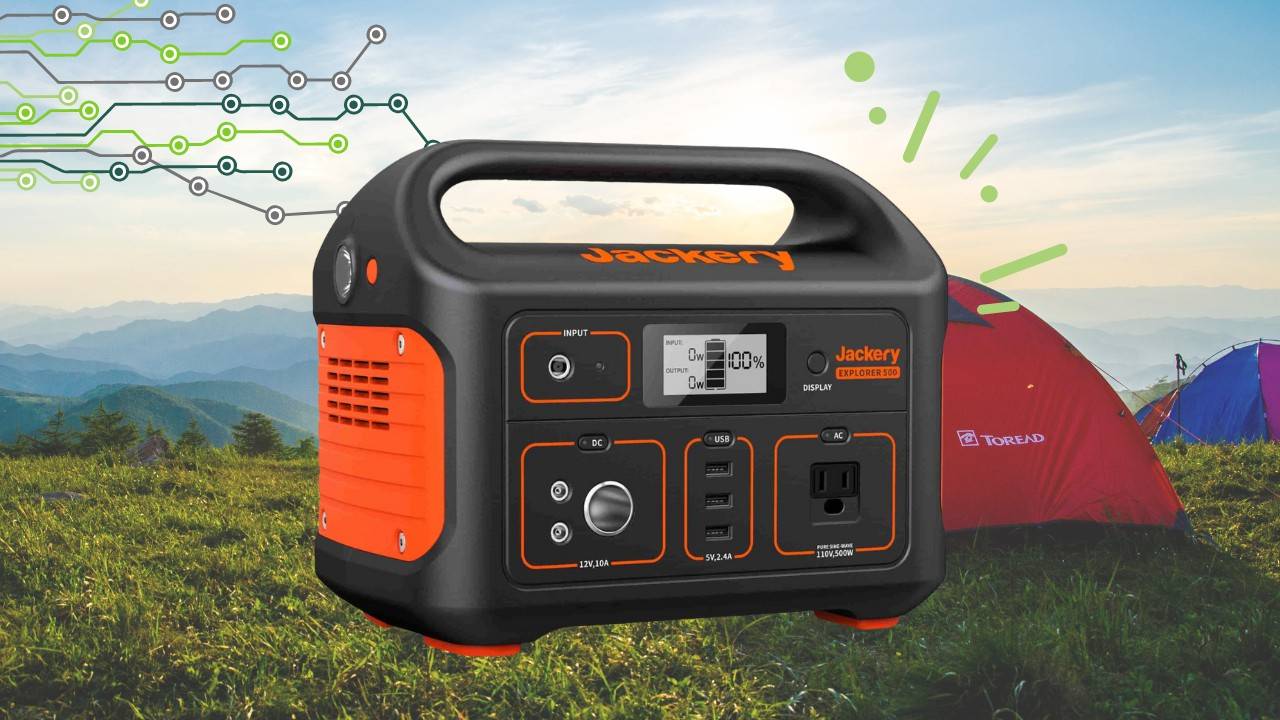
I love camping. Whether it’s at festivals, campsites, or the middle of nowhere, I love to just get in my car and go explore the great outdoors.
With that said, I still love my digital comforts. After a long day of looking at nature, I want to watch some shows on my tablet or play some music on my Bluetooth speakers.
Last time I checked, Mother Nature doesn’t have outlets on the side of trees, so I needed to find a decent portable power station — preferably one that was environmentally friendly.
After a couple of misfires, I eventually got my hands on the Jackery Explorer 500 and was able to try it out.
What Is The Jackery Explorer 500?
The Jackery Explorer 500 is a portable power station that can store and deliver electricity as per your need. While we label them as "solar generators" sometimes, they can't actually generate electricity.
This mini power station is great for — camping, exploring, and living off-the-grid, or during power outages at home caused by natural disasters and extreme weather conditions. In short, this could be one of the best portable solar generators for RV.
It has multiple outlets to power a range of devices, as well as a 2-inch LCD display that tells you exactly how full the battery is.
You can charge the Jackery Explorer 500 portable power station either from a household power outlet, your car’s cigarette lighter charger, or through solar panels.
Obviously, here at GreenCitizen, we would suggest using solar panels to be more environmentally friendly.
Jackery actually makes their own to go along with this power station — the foldable SolarSaga 100W Solar Panel Kit.
The Jackery Explorer 500 portable power station comes with:
As you can see, the Jackery power station has over 500W of power capacity and gives you multiple options for power outlets of different types.
What Can The Jackery Explorer Power?
As the name suggests, the Explorer 500 has 500 watts of power, which means it’s best for powering smaller devices like cell phones, cameras, laptops, and small TVs.
The device you’re using must draw 500W or less (you can find this information on the cable).
Also, the Explorer 500 will automatically shut off if you try to plug in a device that draws more than 500W, such as a hairdryer or an electric kettle.
Usually, if an appliance heats itself up quickly, like a coffee maker or a toaster, then it probably uses more than 500W of power.How Do You Charge A Jackery Portable Power Station?
There are 3 ways to charge the Jackery Explorer 500 —
The 500 comes with cables for household charging and car charging, but you need to buy solar panels separately if you’re going to go down the green route.
Read More:
How Long Does It Take A Jackery To Charge?
How long it takes this power station to charge depends on the charging method you’re using.
So, I’ll break it up into the 3 main charging methods and how fast they work:
How Do You Keep Track Of The Jackery Explorer 500’s Charge?
The Explorer 500 comes complete with one 2-inch backlit digital display that tells you the battery percentage, the input/output in watts, and the battery temperature.
Jackery Explorer 500 Benefits
Plugs In Multiple Devices Simultaneously
The Explorer 500 has multiple outlets and USB ports, so it’s possible to charge several smaller devices at the same time depending on the power connections they require.
I love this because I can just charge my phone and tablet with the USB slots while charging my laptop via the 110V AC outlet.
I can leave them all charging in my tent, go for a long walk, and then return to find them all fully charged (or near enough).
This is also useful in case of an emergency during a power outage or natural disaster. That's when I would need to charge several electronic devices at once so I can quickly ask for help if I need to. It's a lifesaving feature, really.
Operates In High Temperature
The Explorer 500 can operate safely between the temperatures of 32-104°F (0-40°C), so it’s able to withstand the heat on very sunny days.
If you live in a hotter part of the country, it’s essential to find a portable power station that won’t die on you when the heat gets intense.
This is an important consideration these days especially with climate change, where wildfires and heat waves in many areas have become almost like a way of life for some people.
The Explorer even has low-power cooling fans that kick in when things get heated. What’s great is they’re very quiet, so they won’t disturb your peace while you’re communing with nature or just trying to get a respite from the heat.
Eco-Friendly Option
One of the best things about the Explorer is that you can charge it with solar panels.
Best to use the Jackery SolarSaga 100W foldable solar panel kit to charge the power station without burning any fossil fuels in the process.
In full sunlight, it takes around 16 hours for a full charge that doesn’t harm the environment.
For quicker charging option, you can connect multiple solar panels. If you're an avid camper like me, you can get a portable solar panel too.
Compact Size and Portability
I don’t know if you’ve ever tried to take a generator camping with you, but it’s a pain in the butt.
They’re huge, heavy, and messy.
Not the Jackery, however.
While it produces less power, it’s quite small and compact — just about the size of a handheld radio. It’s also fairly lightweight, coming in just below 14 lb, so I found that it’s not too difficult to carry around with me in my backpack.
This also means that you can easily pack it up if you would need to, say, evacuate during an emergency or natural disaster and you need to bring backup power with you.
Built-in High Quality LED Flashlight
This power station comes with a built-in LED flashlight on the side.
This is perfect if you’re walking around late at night and your headlamp fails on you or your flashlight dies down.
It’s by no means the strongest beam of light in the world. But I once had it on for 12 hours straight without draining the battery by even 1%.
So, it’s super low-demand.
It’s nice to know I’ve always got a backup light source in the woods or during a blackout with this.
Digital Display Shows You The Charge
Have you ever used those portable power stations where you only have a few little blinking lights to tell you how much juice is left inside the battery?
They’re incredibly annoying and vague.
However, the Explorer 500 tells you exactly what percentage of your battery is left.
This means you’ll never be left in the dark wondering when your laptop or TV will shut off.
Jackery Explorer 500 Shortfalls
While I do really like this power station, there are a few downsides that need to be addressed.
For example, I have a couple of USB-C devices that I would like to charge, but the 500 only has regular USB slots, no USB-C slot! It would be nice to see some more modern connection options from this company in the future.
This power station also isn’t waterproof, so you need to be careful if you’re using this in a rainy climate. To be fair, a lot of these power stations aren’t waterproof, but it’s something you need to keep in mind.
Lastly, the little digital display turns off its backlight automatically after a few seconds.
While I understand it’s saving energy, it can be frustrating because I must physically walk over to the battery and light the screen up when I want to check the battery percentage level. Not ideal.
Pros and Cons Summary of the Jackery 500
Pros
Cons
Things To Consider Before Buying A Portable Solar Generator
What Power Capacity And Wattage Do You Require?
The first thing you need to consider is how many watts you need. The amount of power that a portable power station can hold is usually measured in watts (W).
The more watts a power station has, the more electricity it is able to supply you with.
You need to take a look at your electrical devices and figure out how much power you need, whether you're going to be using it for camping or as backup power at home in case of emergencies.
For example, a 500W power station (like the Jackery) gives you approximately 50 smartphone charges and 20 tablet charges, depending on the size.
Some electrical appliances, like hairdryers, draw a lot of power and may not work when plugged into power stations with lower power capacities.
Do You Have The Right Solar Panels?
If you’re going to charge your power portable battery with solar panels, you need to make sure that the solar panel kit is compatible with the power station you’re using.
Most campers and explorers use 100W solar panel kits that are designed to charge solar power stations.
Do You Need To Charge Multiple Devices At Once?
Some portable power stations have a limited number of inputs and outlets, so you may only be able to charge one device at a time depending on the type of power connection you need.
If you need to charge or power multiple 110V AC devices at once but your power station only has one 110V AC outlet, then you’re out of luck.
Are You Clumsy Or Heavy-Handed?
Many portable power station devices are designed to be housed in lightweight materials like plastic, as this reduces their overall weight (which is often necessary when camping).
However, the lighter your power station is, the easier it will be to damage.
If you’re clumsy or prone to throwing things around haphazardly, you could damage your power station.
FAQ
The life of power station batteries depends on its wattage, capacity, and what you’re using it for. If you’re looking to use a few basic things such as a small TV, a couple of lights, and charge your electronic devices, you’re usually looking at around 4-8 hours of battery life.
Jackery is owned by a former Silicon Valley Apple Engineer who worked on designing batteries for Apple smartphones. They launched the company in 2012 and by 2015 the company sold the world’s first Lithium Power Station.
Yes, all Jackery power products use lithium batteries because they’re lightweight and can hold a lot of charge. They were actually the first company to produce off-grid lithium batteries back in 2015.
Generally speaking, you can take Jackerys on planes so long as they’re in your carry-on bag and not your checked luggage. However, there are conflicting reports of some people having their devices confiscated by airport security, so do your research for the regions you’re traveling to and from.
A portable power station works by taking in energy, storing it, and then allowing you to plug in appliances or charge electronic devices with the stored energy. The devices can usually be charged via a home AC outlet, a car charger, or specialized solar panels.
Yes, this generator from Jackery can power a common mini fridge.
The Jackery Explorer 500: Should You Buy It?
If you’re a casual camper or you just like the idea of having backup energy in your home when a power cut hits, then I would recommend you try the Jackery Explorer 500.
However, if 500W just isn’t enough juice for you, you could try the Jackery Explorer 1000 instead for twice the wattage.
I’ve had a lot of problems with small power stations that don’t give you much information to work with, so I was really happy when I found the Explorer.
Now I know exactly where I’m up to with my battery life and the input/output display means I don’t have to worry that I’m pushing it too hard with the wattage.
Next time you’re going camping or experiencing a blackout, I’d recommend using an Explorer 500.

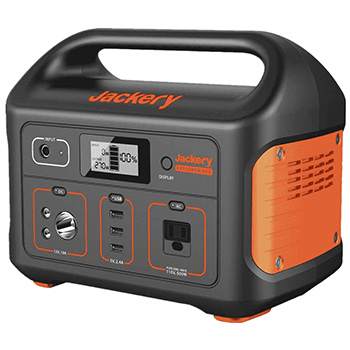
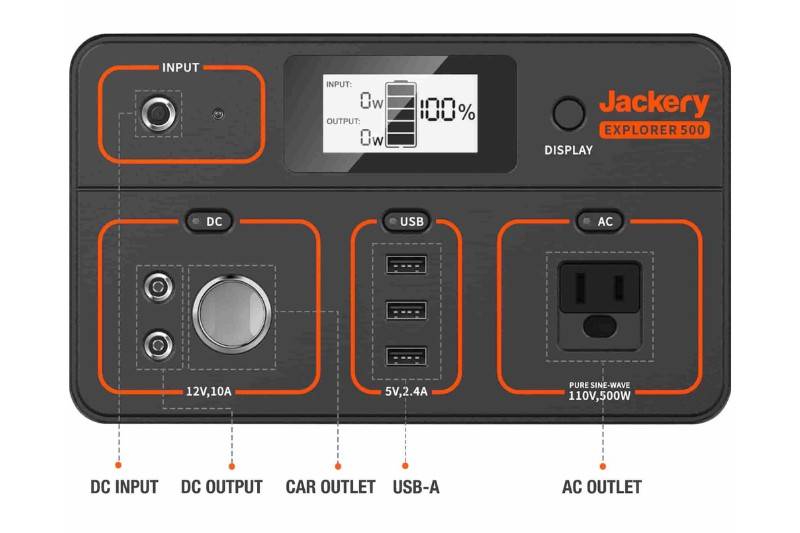

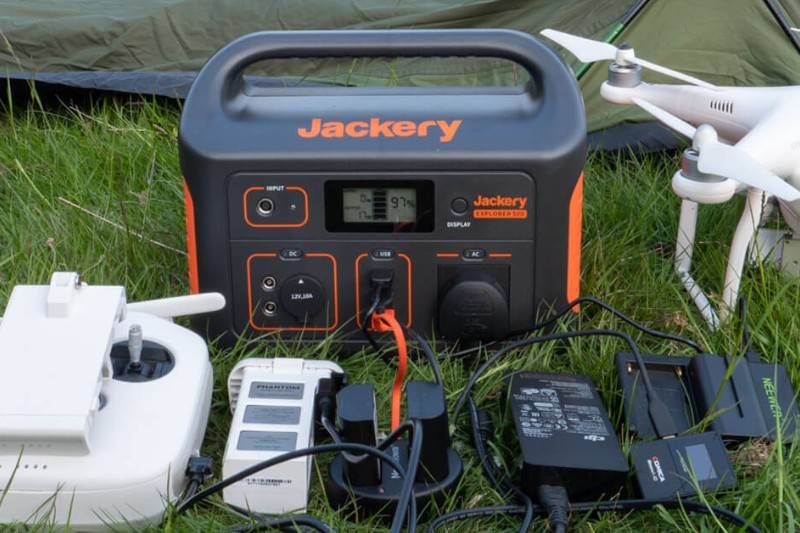
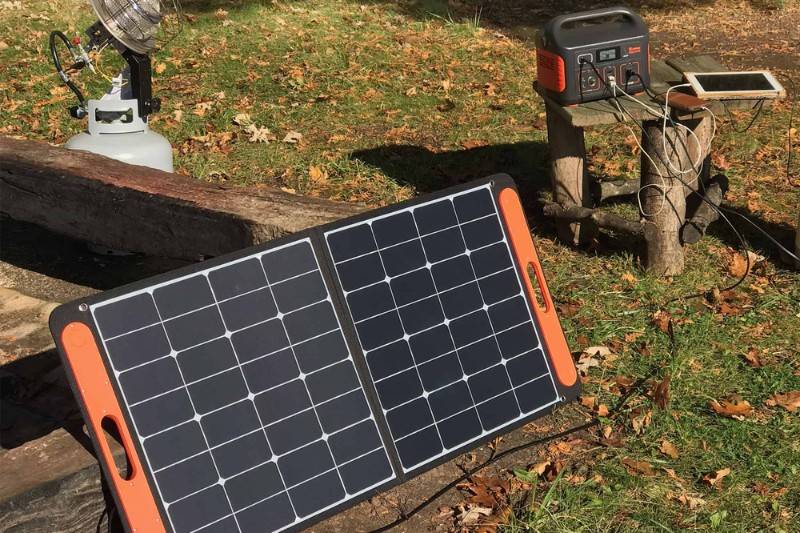
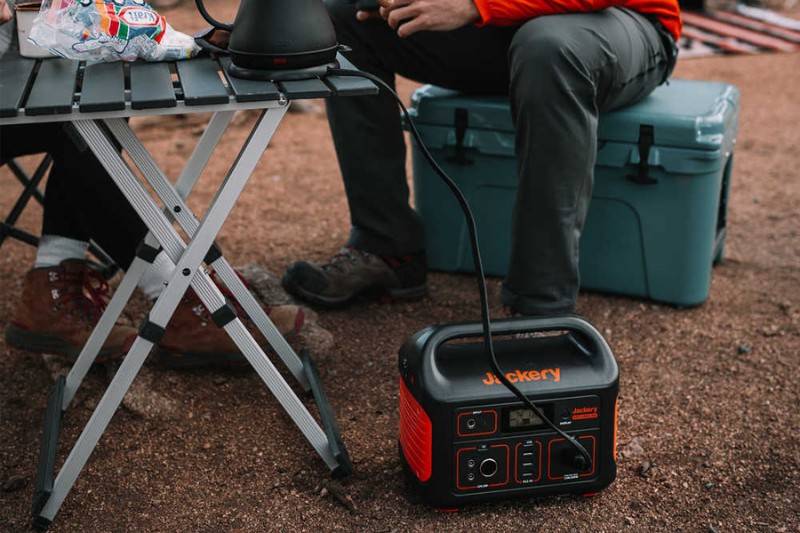
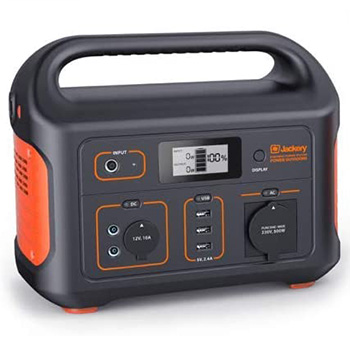








When you think about camping and you’re gonna go out there on a consistent basis. Do you want to have dependable power for your RV? Then a small portable generator like a Honda EU2200i will last you a lifetime, and you can also converted to either gas or propane tank! Where, with any of these battery supported solar generators you can only recharge them 500 times. Then your investment is gone.
If you only plan on camping, or using it maybe a couple dozen times a year well then maybe you’d get 20yrs use, but they are so new on the market. No one knows how long they will really last. Same goes for Goal Zero. And another thing one and thing is by American, we’re goal zero is made in America, and Jackery is manufactured in The Peoples Republic of China. Which more Americans should be thinking about, we will eventually be at war with them over Taiwans sovereignty, the whole world is heating up, so one must prepare for it. Your best bet is to have both solar back up generator and solar panels, and a convertible, gas generator you can run on propane, and some of them offer conversions to run off of natural gas from your home
I have one of these with the solar panels. The fan kicks in every couple of minutes on anything drawing 25 watts and above and permanently on anything above around 75 watts and its not a quiet fan. I’ve contacted Jackery about this but so far I’ve just been passed from pillar to post despite doing everything they asked, resetting, sending them videos etc. I’m fairly certain the fan shouldn’t be coming on as it does and I’d quite like them to fix it, they were quick enough to take my money. It does the same regardless of ambient temperature.
Definitely, I am going to buy a new one. Love this review
Pingback: EcoFlow Delta 1300 Review: Scam or Legit? (2021)
Jackery Explorer is listed my one of the top tools.
Very Informative article. I was looking for exactly the one. Me and my friends have planned a camping trip in a state and I was looking for the solution to our power usage. Was searching the internet and found you. After reading your article I know exactly what I need for our camping trip. Thank you so much for sharing it. I also found a discount code for this model which saves me about $50+ and I’m happy with my purchase. Once again thanks a lot for sharing this knowledge and helping many others like me.
Thank you very much for your inspiring comment!
Can you buy replacement batteries for your Jackery?
In use with air sense 10 Capp and using a jackery 500 power pack should the fan keep coming off and on continually
Thank you for your article. My Goal Zero Yeti 500 eventually died and I’m thinking about buying the Jackery 500. I’m wondering if my solar panels and lights from Goal Zero will work with the Jackery? Do they use the same input / output connections or did Goal Zero make sure that their accessories only work with Goal Zero (and did Jackery do the same with their devices)?
I just picked up the Goal Zero 100 watt solar panels and they indeed connect to this unit. I have yet to actually test it out as I just got everything today. I got the Jackery because it looked like it was better built, but the Goal Zero panels are top of the line so while I’m pretty sure, based on the connection, that they will work, I can’t yet say 100% but I will let you know!
The solar panels should work as long as the voltage is right , but you may need to change the plug or find an adapter to fit the Jackery.
Can I use a 150 watt solar panel with the 500
Did you buy 150w panels and do they work?
I’ve just bought a 150w panel as the voltage output is within the input range if the jacket 500.
If the Voltage and plugs are right it should work. Realize the Jackery limits the rate of charge it can receive. I am not sure if 150W would get there, but if it does, it just won’t use the extra power that the panels are providing.
GreenCitizen is an environmental conservation company providing you with information, services, and products to help you live a sustainable life.
Follow Us
Join Our Newsletter
Quick Links
Blogs
Services(United States)
For Businesses
For Homes
Useful Links
Copyright © 2024 · All Rights Reserved · GreenCitizen
Privacy Policy | Affiliate Disclosure